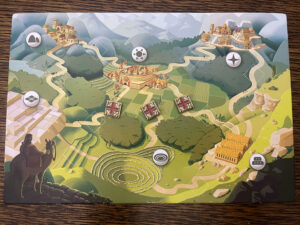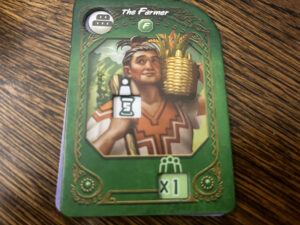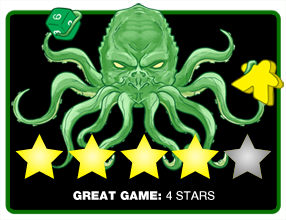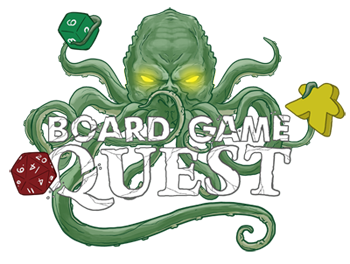 Since I reviewed Kronologic: Paris 1920 in January, we have gone on to play every scenario and restarted with Grandparents. Just like I mentioned in that review, if there is enough time between game plays, there is no way you will remember the ending, which ensures its replay value. That being said, the family has been asking me when another version was coming out, and now I get to tell them Kronologic: Cuzco 1450 is here.
Since I reviewed Kronologic: Paris 1920 in January, we have gone on to play every scenario and restarted with Grandparents. Just like I mentioned in that review, if there is enough time between game plays, there is no way you will remember the ending, which ensures its replay value. That being said, the family has been asking me when another version was coming out, and now I get to tell them Kronologic: Cuzco 1450 is here.
The question is, did it live up to the hype?
Gameplay Overview:
Please read my review of Kronologic: Paris 1920 to learn the mechanics of this social deduction game, as I am only going to highlight the differences. This game is not an expansion; it is a new environment with three new scenarios and requires nothing from the original game. Just like the original, there are three scenarios (with five unique games in each scenario), each with different difficulties from 3 Stars to 7 Stars. The game is played by one to four players. Each scenario has six suspects, six locations, and six time frames that you can investigate. Each suspect is in a location on the map of Cuzco at all times and must move to an adjacent location each time. Except for in Scenario three, they can only move one location at a time and never stay in the same location. New to this version, each location has a passage to three other locations not just 1-2, but some of these passages get blocked in individual games.

In the first scenario, The Golden Sceptre, each player is trying to identify the two characters chosen by the Sun God to place the Golden Sceptre in the sacred location. You are given the starting location of characters and what passages are blocked and need to determine who the chosen characters are, which location is the sacred location, and in what time these two are in that location together. The only hint is that this will be a location that only the two Chosen characters visit, and no one else visits it.
In the second scenario, The Curse of Amarinta, each player is trying to discover who was cursed by the goddess Amarinta in timeframe one. You are given who was cursed in time six and you know that whenever a character is in a location with the cursed character, they gave that character the curse in each of the six time frames. It is like tracing a game of tag back to the start.
In the third scenario, The Ritual, it is all about sacred dancing. Each character moves in clockwise circles according to a dance assigned to them, which is a sequence of 3 moves that repeat in a cycle (ex: 1-2-3-1-2-3). You are trying to find the location of each character in Time 6 and you also only know a few character’s dance sequence at the start, but not where in the sequence they are in Time 1. It is nearly as complicated as it sounds.

Game Experience:
Instead of asking players questions like in Clue, each player takes turns finding out information about one suspect’s movements through a location or how many suspects were in a location at a given time. In a continued great mechanic, each query gives the active player a piece of secret information and a piece of information that they must share with the other players. Players then write down the public information, and the active player also writes down their private information on their note sheet.

The Golden Scepter ended in multiple ties for my family, which never happened in the original game, so I am not sure if we are just familiar with the game or if this is a flaw. My wife liked that we tied; my competitive children hated that we tied.
During the Curse of Amarinta, we had multiple games where people guessed wrong, which I think is great. This is partly because, since we all did so well in the first scenario, we were trying to deduce some information without having all of the details in an attempt to win.
The Ritual has so many things to solve that your brain hurts. You need to figure out each character’s dance/pattern and where they are in that dance to then predict the final location. This is the hardest scenario in all of the games and is not for everyone, but the challenge is fun.
Final Thoughts:
If you like murder mysteries or deduction games, go out and buy Kronologic: Paris 1920 first. If you want to have additional challenges, pick up Kronologic: Cuzco 1450. The variability of 15 games across the three scenarios is again a sufficient number of games to allow for replaying. The game just didn’t grab me the way Paris did. It was complex to be complex and was not quite as fun. It is still good, and worthy of a pick up if you already like Kronolgic: Paris 1920.
Final Score: 4 Stars – Fun Deduction game with good replay value, that’s easy to set up, just not as easy to play or asa fun as the original, but the three scenarios still feel like a different game each time that you play.
 Hits:
Hits:
• High replay value with very different scenarios
• The Kronologic system continues to be an excellent way to play a deduction game.
Misses:
• Scenario three is complex to be complex, but is still enjoyable
• I am not a fan of the multiple ties that we experienced.




















